I have a rhyming sister! Rhonda Gowler Greene is here to talk with us about writing lyrical picture books and working successfully with an agent for more than 20 years.
We are rhyming sisters not only because we both love writing rhyming picture books, but also because we have picture books that are cousins; Rhonda’s FIREBEARS (Holt) and my PILOT PUPS (Simon & Schuster) are first cousins. Both books are illustrated by Dan Andreasen, feature bouncy rhymes, and showcase animals with adorable noses doing daring rescues to help their community.
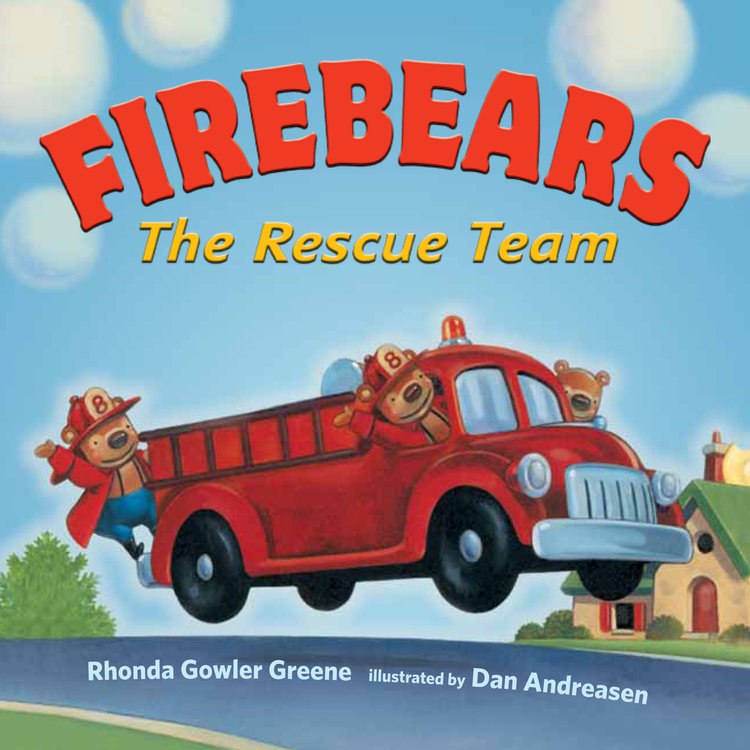
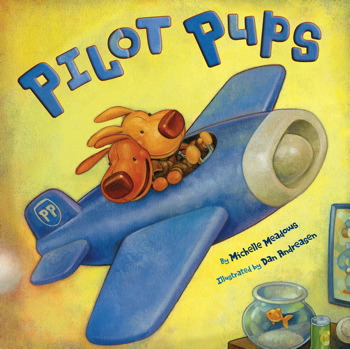
Next, here is a medley of several of Rhonda’s covers below. I really admire the impressive range of Rhonda’s rhymes.
From the cozy rhymes in AT GRANDMA’S: Big bed, yellow sun, breakfast bread with cinnamon
To the clever rhymes of WHEN A LINE BENDS, A SHAPE BEGINS: A line is thin. A line is narrow — curved like a worm, straight as an arrow.

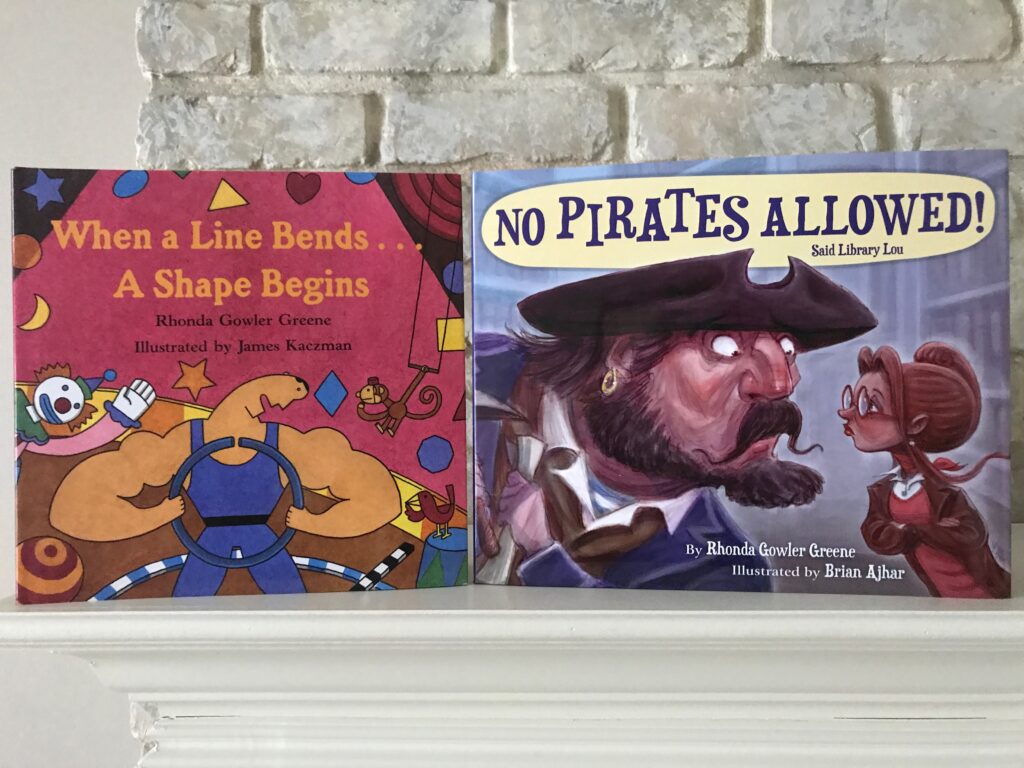
And now, let’s hear from Rhonda!
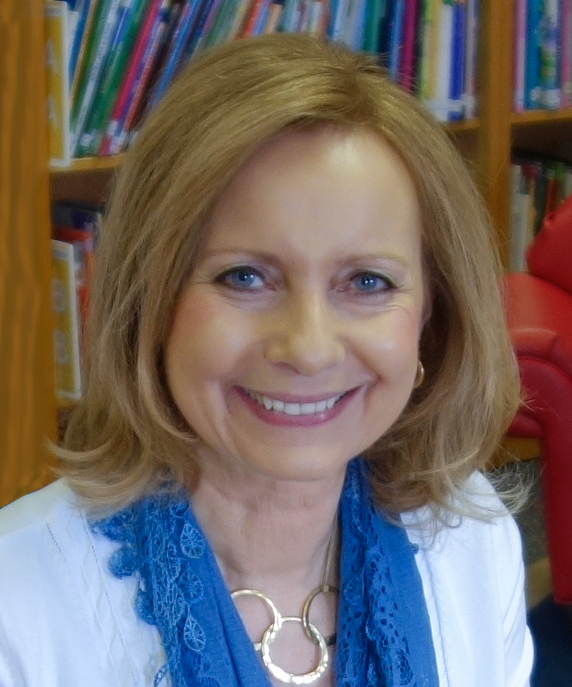
How many books have you published and how many are in rhyme?
Twenty-eight picture books – I feel very lucky! My first two sales (S&S/Atheneum and HM, now HMH) were 25 years ago. Before that, I received 220 rejections on about a dozen different stories. My motto? Never give up.
So far, all my books are in rhyme. In some, I use a format that doesn’t have a basic four-line rhyme scheme though. In those, I use three lines, with the first two rhyming but not the third. It’s a pattern I came up with several years ago that also includes line repetition and a text that circles back to the beginning. My THE VERY FIRST THANKSGIVING DAY and THE FIRST MEN WHO WENT TO THE MOON are written this way. My editor on the moon book commented the text has a majestic feel. I think the format gives it that feel.
I agree with your editor! This spread is quite beautiful.

And what draws you to writing in rhyme?
A couple of things especially draw me to writing in rhyme – I love lyrical language and I have a music background (minored in music/piano in college).
What I love most is playing with words, getting those just-right words. To me, writing in rhyme is like putting a complicated puzzle together. It’s challenging, but also fun and very satisfying when you get everything to fit, and almost perfectly. I think writing in rhyme is much more difficult than it looks.
Too, I like using various patterns. Rhyming patterns give a ‘good’ kind of predictable structure for young children. In some of my books, I use a format loosely based on ‘The House That Jack Built.’ In my PUSH! DIG! SCOOP! A CONSTRUCTION COUNTING RHYME, I used the ‘Over in the Meadow’ pattern. (That manuscript sold at auction. Exciting! Four publishers were bidding.) And, my SANTA’S STUCK and FIREBEARS THE RESCUE TEAM have refrains throughout.
What are your top tips for authors who want to write in rhyme?
1. Read read read great rhyming picture books, especially ones published by major houses within the last five years or so. Think on why the texts in them are so good. A new favorite of mine is THE SCARECROW by Beth Ferry.
2. Study children’s poetry books, even if the poems are in free verse. Two things poets use are fresh language and tight writing. That’s a perfect combination to study in order to write rhyming picture books.
3. Especially work on word choice for end rhymes and also getting the rhythm, or accented beats per line, spot-on. When I critique rhyming manuscripts, the two biggest problems I see are forced rhymes and trying to squeeze too many beats in a line. The rhymes have to fit the story so well. You have to be a wordsmith. Delight the reader.
4. Use alliteration. I love alliteration! It gives a lyrical quality to writing.
5. Use internal rhymes – these are also great when you can fit them in. When I wrote WHEN A LINE BENDS…A SHAPE BEGINS, the editor kept throwing out my ending. Finally (after weeks of thinking), I came up with…
“Anywhere, everywhere, shapes big and small—
dependable, bendable lines make them all!”
When she read ‘dependable, bendable,’ she said, “That’s it!”
Love it! When I work on a picture book, I scribble a lot in notebooks, paper is scattered everywhere, and I eat a lot of chocolate chip cookies. Please tell us about your writing process when you’re working on a picture book.
When I get an idea, I jot it down on paper with the date and what prompted it. Most of my ideas come when I’m studying other children’s books. Sometimes, though, a phrase will pop in my head and I start writing around it. That’s what happened with AT GRANDMA’S and the phrase – “bunny slippers on four feet.” (I was thinking people – a child and a grandma, but Karla Firehammer illustrated the characters as dogs. Fun!)
Next, I start writing a first draft at my computer. Sometimes I make a very loose outline. Then, I revise for months. During revision, I especially work on verbs, end rhymes, and making the text super tight. (My NO PIRATES ALLOWED! SAID LIBRARY LOU had 37 revisions. Once it sold, I had to revise more!)
I often print out a work-in-progress and carry it around with me in the house so I can jot down better lines that come to me. I usually make a 28-page dummy. I tweak. I set the dummy aside for a few weeks. I tweak again until I think the story is ‘there.’
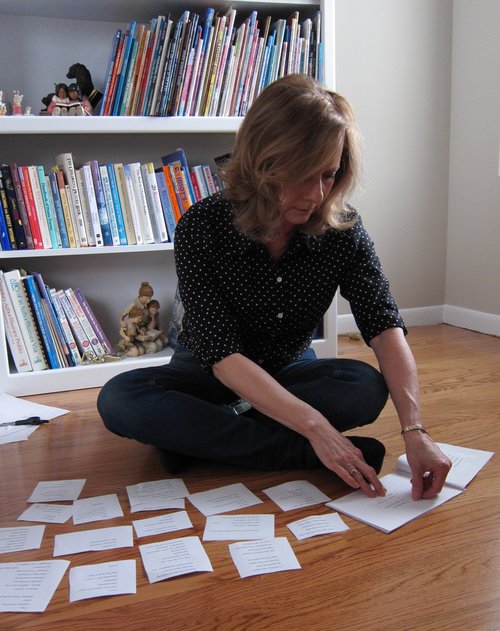
Hooray for dummies! I think it’s fun to work on them. I think this is also like putting a puzzle together — kind of similar to how you mentioned that crafting rhymes is like putting a puzzle together. And how about your research for non-fiction?
If the book I’m working on is non-fiction, I also spend weeks researching. For my Apollo 11 book, I read SO many books (kid and adult ones) about the Apollo space program, etc. Plus, I researched on NASA’s website and took pages and pages of notes. My book has sidebars with facts and also back matter, which are all in prose.
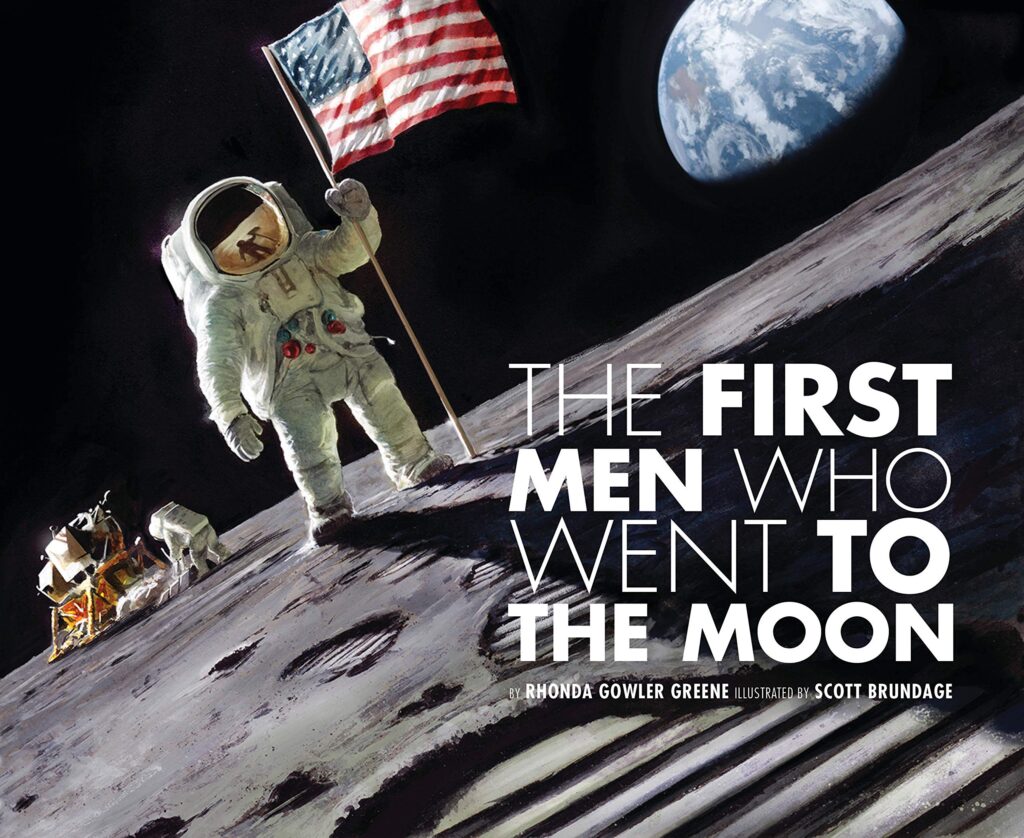
You have worked successfully with an agent for more than 20 years. How do you work with your agent?
I’m represented by the wonderful Elizabeth Harding at Curtis Brown, Ltd. (Marilyn Marlow, a legend in her field, was my first agent (1996). Sadly, she passed away in 2003. Elizabeth, at one point, had been Marilyn’s assistant.)
Normally, I have a manuscript fully written, ready to go, before sending it to Elizabeth. Sometimes, I run ideas by her before writing a story. I recently did that. She loved the idea and now I’m working on a first draft. If she has editorial suggestions, they’re usually not major ones. I think that’s because I spend so much time making a manuscript as close as I can to being saleable before sending it to her.
Elizabeth usually decides where to send my manuscripts. However, she’s very open to my input. If a manuscript of mine is rejected, she tries it again and again with other publishers. Every month, we catch up with a long call. In between calls, we touch base by e-mail. Currently, she’s circulating six (rhyming) manuscripts of mine.
Wonderful! What’s next for you and do your forthcoming books rhyme?
I just signed a contract for a picture book with Little Bee Books. I’ve never worked with them, so I’m excited. It’s called THIS MUSIC NIGHT. It’s about a night at the symphony. The story is in rhyme, of course, since it’s about music! I got the idea while attending a Detroit Symphony Orchestra concert. I worked on the manuscript nonstop for six months. Though I haven’t received the editorial letter yet, I figure I’ll have to revise some. It’s always hard revising when your manuscript is in rhyme and already tightly written. (It’s 424 words.) I used rhymes like diminuendo/crescendo, and pizzicato/spiccato. So, I’m a little nervous about how much revision I might have to do.
Also, I just got an offer from Scholastic/Little Shepherd for a (rhyming) nativity story. The editor asked me to revise (and cut a lot) before she took it to acquisitions. It was already short — 145 words. I got it down to 66 words! It’s hard giving up stanzas you’ve worked and worked on and that you love, but I’m happy for the sale! The tentative title is CHRISTMAS IN THE STABLE. It’s going to be a novelty board book with touch-and-feel textures on the cover and inside. My first novelty book!
Someday, I hope to have a book published that isn’t in rhyme. But for now? I love writing in rhyme!
Rhyme on, sister! Your writing journey is exciting, and I can’t wait to read your forthcoming books. Congratulations and thanks for taking the time to share at Picture Book Builders.
Happy Reading! Happy Rhyming! And thanks so much for having me!
***GIVEAWAY***
For a chance to win a copy of THE FIRST MEN WHO WENT TO THE MOON, leave a comment by April 10. I’ll announce the randomly-selected winner in my next post.
Congratulations to David Malcolm for winning a copy of BRAVE BALLERINA from my last post.
Thanks & see you next time!
-Michelle

Great interview Michelle. I agree that music and writing go hand in hand. Congrats Rhonda on your success. Your hard work and determination certainly paid off.
Hi Deborah! Thanks for reading and enjoy the weekend!
Wonderful interview! Thanks for the great tips as well. Excellent info for writing period, but also writing in rhyme.
Thanks for reading, Angie!
Such fun books! I’ve read many of them and can’t wait to read these. Thanks so much for sharing and the great tips!
Hi Lynne! Enjoy the weekend!
There are some really good tips here. Thanks for sharing.
Thanks for reading, Cindy!
I appreciate especially your well-put rhyme suggestions. I’d love to share with my students if it’s okay!
Thanks, Susie. Sure, it’s totally okay to share them with your students.
I have to giggle about Rhonda’s dream to write a PB not in rhyme while I sit here trying my hardest to write a PB book in rhyme . I even write bare foot so i have even fingers and toes to count my beats. Blessings on such a talented author who shares her talents with readers around the world.
That’s funny about bare feet, Terri. Happy Friday!
I’m working on a rhyming manuscript, so this was helpful! Thanks.
Perfect timing! Good luck with your manuscript!
Thanks for the great post! My notebooks are the first place I start, the hardest part is figuring out which one each story idea is in!
Mary, I sometimes have that problem too. So many notebooks…
This was such a fun post. Loved the background and hearing the number of rejections is always a confidence booster to keep going. Many thanks to Michelle and Rhonda! Looking forward to adding some of these titles to my TBR list.
Hi Kim! Thanks and have a great weekend!
This looks fabulous! And hooray for fellow-rhymers! Congratulations, Rhonda!
Hooray indeed!
Thanks so much for sharing. Rhyming is harder than most people think, but when done correctly, looks effortless! Congrats!
Thanks for visiting PBB, Danielle!
Oh my library is going to have such a BIG list of books on my hold list when they re-open! Thanks for sharing these!
Hi Cathy! I really miss going to the library. Thanks for reading!
Thanks for this interview. People need to understand that rhyming stories are about more than finding words that rhyme. Without structured meter, it doesn’t work. It’s much tougher than it looks.
Agree! Thanks, Kathy!
Love rhyming picture books and admire the many authors who excel in meter, rhyme, and good story!!
Yes! Thanks, Mary!
Thanks for the interview! I admire authors who can write perfect rhyme and can’t wait to read this book which is on one of my favorite topics.
Hi Danielle! Thanks for reading!
What a wonderful interview! Thank you for your inspirations and ideas! “NO Pirates Allowed!” Said Library Lou is one of my favorites for reading to my library classes at the beginning of the school year! The First Men Who Went to the Moon would be a great way to show students how rhyme and informational text CAN go together!
Hi Annette! Enjoy the weekend!
Hi Annette, Nice to hear you use my “No Pirates Allowed” book with your students!
I’ve never had the courage to even try writing a poem, let alone a book in rhyme. I’m impressed and amazed that everything you’ve written is in rhyme!
Thanks for reading, Mary!
Thanks for this interview! I enjoyed hearing about her work and success with rhyming.
Hi Cindy! Thanks for reading!
I enjoyed reading about your hard work. I love rhyming books, but I can’t rhyme.
Keep up the good work. Your perseverance is inspiring
Truly inspiring! Thanks for visiting Picture Book Builders!
Thanks to everyone for your kind words! I hope the interview was helpful and inspiring.
Thank you very much for sharing! I read so much online about agents/publishers not being overly fond of rhyming picture books, so this is extremely encouraging and inspiring.
Hi Josh! Thanks for the feedback and enjoy the weekend!
Great interview! I look forward to ordering these books from my library.
Thanks for reading!
So much goodness in this post. Thank you for the tips and for giving me more rhyming titles to add to my book list, Michelle and Rhonda. 🙂
Thanks, Bridget! Happy Reading!
Wonderful interview! I love Rhonda’s books and her tips for writing in rhyme are very helpful!
Hi Judy! I love them too. Thanks and enjoy the weekend!
What a great post! Kudos for all the revision work you do!
Thanks for reading, Cynthia!
Love it! Thank you for those great tips!
Thanks, Lenora! Enjoy the rest of the weekend!
This is a fantastic interview. I’ve bookmarked it. Thank you for sharing it!
Hi Lynn! Thanks for reading!
Wow! Rhonda, I know it is extremely hard to write a picture book in rhyme. What an amazing journey…and interview. Thank you for sharing.
What a fantastic interview. Thank you, Rhonda, for sharing your process. So helpful.
Great interview! Thank you for the writing tips!
Thanks for this wonderful interview, you two! So inspiring. 🙂
(And Rhonda, small world—Scott B is the illustrator of my next book!)
Superb perspective for us rhymers! (37 revisions? Hip hip hooray! I’m normal!) Tip#3 jumps out. Rhythm and end rhymes. I recently studied end rhymes in seven longer rhymers (my favorite: the delightful I Am Cow, Hear Me Moo by Jill Esbaum) and only one had a single (charming) slant rhyme that you wouldn’t notice in a million years unless you were studying them as I was! My mantra: shoot for perfect rhymes. I might add that a solid story is a must–no twisting it into knots just to get a rhyme you like. I’m trying to jump into the market with a longer rhymer (that breezes by), which I hear is hard but hopefully not impossible to do. Thanks for this exceptional lesson in rhymers.
Instructive and interesting interview, Rhonda and Michelle. I loved NO PIRATES ALLOWED! SAID LIBRARY LOU.
Great interview. I am in awe of great rhyme . . . Rhonda is a master. Thank you.
Great interview! I can’t believe there were 37 revisions! This really shows the time and attention paid to your craft. Thank you for sharing!
I just discovered ‘Picture Book Builders’ and am hooked after reading this informative, inspiring interview with Rhonda.
Hurry, library/ open your door/
there are lots of books I wish to explore! (c. sheer 4/4/2020)
So happy you found PBB!